
In the ever-evolving landscape of medical science, cord blood and tissue banking stand at the forefront of regenerative therapies, holding the key to potential breakthroughs in treating a wide array of health conditions. Stem cells, with their unparalleled ability to heal and renew, offer a glimpse into a future where previously untreatable diseases may be cured. In this article, we will embark on a journey into the realm of cord blood and tissue banking, exploring their significance, the science behind them, their diverse applications, and how they empower health and hope for the future.
The Significance of Cord Blood and Tissue Banking
The Gift of Life-Saving Stem Cells:
Cord blood and tissue are rich sources of stem cells, which have the remarkable potential to transform into various cell types, including blood cells, nerve cells, and tissue cells. These stem cells hold immense promise in treating a broad range of medical conditions and regenerating damaged tissues.
A Treasure Trove of Possibilities:
The stem cells derived from cord blood and tissue have captured the attention of researchers and clinicians worldwide due to their versatility and therapeutic potential. They offer hope for patients and their families facing otherwise challenging and devastating health issues.
The Science Behind Cord Blood and Tissue Stem Cells
Cord Blood Stem Cells:
Cord blood contains hematopoietic stem cells, capable of generating red blood cells, white blood cells, and platelets. These cells have proven effective in treating various blood disorders, immune system deficiencies, and certain types of cancer.
Cord Tissue Stem Cells:
Cord tissue, particularly the Wharton’s jelly within the umbilical cord, harbors mesenchymal stem cells (MSCs). These MSCs possess the ability to differentiate into bone, cartilage, and fat cells, making them invaluable in regenerating damaged tissues, such as those found in joints and organs.
The Process of Cord Blood and Tissue Banking
Collection:
After a baby’s birth, the umbilical cord blood and tissue are collected using specialized kits. This process is quick, safe, and non-invasive, posing no risk to the newborn or the mother.
Laboratory Processing:
The collected cord blood and tissue are transported to state-of-the-art laboratories. There, the stem cells are isolated, processed, and tested to ensure their purity and safety.
Preservation for Future Use:
Following processing, the stem cells are cryopreserved or frozen at ultra-low temperatures. This cryopreservation maintains the stem cells’ viability and potency, allowing them to be stored for many years, potentially ready for medical treatments when needed.
Diverse Applications of Cord Blood and Tissue Stem Cells
Blood and Immune Disorders:
Cord blood stem cells have shown success in treating various blood disorders, such as leukemia, lymphoma, and anemia. They can replenish the blood and strengthen the immune system.
Regenerative Medicine:
Cord tissue MSCs hold immense promise in regenerative medicine. Ongoing research explores their potential applications in joint and tissue repair, heart diseases, and neurodegenerative conditions like Alzheimer’s and Parkinson’s.
A Beacon of Hope for the Future
As research continues to advance, the potential applications of cord blood and tissue stem cells are boundless. Clinical trials and studies pave the way for groundbreaking treatments, offering hope for patients and their families.
Conclusion
Cord blood and tissue banking is a journey into the realm of regenerative medicine, where hope meets science in the quest for improved health and better lives. The stem cells preserved in cord blood and tissue represent a beacon of hope for the future, with the potential to transform medical treatments and unlock new possibilities. By investing in cord blood and tissue banking, families are taking a proactive step toward a healthier and more promising tomorrow.
Reference: https://cellgenesis.com.sg/umbilical-cord-blood-banking-cost-benefits-tissue-companies/